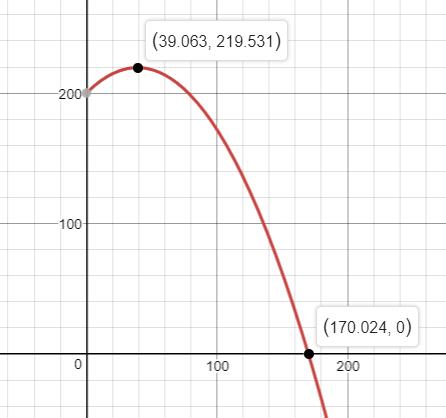
Analyzing the Motion of a Projectile A projectile is fired from a cliff 200 feet above the water at an inclination of to the horizontal, with a muzzle velocity of 50 feet per second. The height of the projectile above the water is modeled by
where is the horizontal distance of the projectile from the face of the cliff.
(a) At what horizontal distance from the face of the cliff is the height of the projectile a maximum?
(b) Find the maximum height of the projectile.
(c) At what horizontal distance from the face of the cliff will the projectile strike the water?
(d) Using a graphing utility, graph the function , .
(e) Use a graphing utility to verify the solutions found in parts (b) and (c).
(f) When the height of the projectile is 100 feet above the water, how far is it from the cliff?
To calculate:
a. At what horizontal distance from the face of the cliff is the height of the projectile a maximum?
b. Find the maximum height of the projectile?
c. At what horizontal distance from the face of the cliff will the projectile strike the water?
d. Graph the function , using a graphing utility .
e. Using graphing utility verify the solutions found in (b) and (c).
f. When the height of the projectile is 100 feet above the water, how far is it from the cliff?
Answer to Problem 11AYU
Solution:
a.
b. feet.
c. 170ft.
d. The graph is given below.
e. The graph is given below.
f.
Explanation of Solution
Given:
A projectile is fired from a cliff 200 feet above water at an inclination of 45degree to the horizontal, with a muzzle velocity of 50 feet per second. The height of the projectile above water is modelled by
, where is the horizontal distance of the projectile from the face of the cliff.
Formula used:
For a quadratic equation , we have
Calculation:
a. The height of the projectile is a quadratic equation with . Since is negative, the vertex is the maximum of the given function. Therefore, the maximum is .
Thus, at , the height of the projectile is maximum.
b. The maximum height of the projectile is at
Thus, the maximum height of the projectile is feet.
c. Now, we need to find the value of at .
The projectile will strike the water at a horizontal distance of 170ft.
d.

e. From the above graph, we can see that the answers in (b) and (c) are true.
f. Now, we have to find when .
When , we have .
Chapter 3 Solutions
Precalculus Enhanced with Graphing Utilities
Additional Math Textbook Solutions
Calculus: Early Transcendentals (2nd Edition)
Elementary Statistics: Picturing the World (7th Edition)
University Calculus: Early Transcendentals (4th Edition)
Algebra and Trigonometry (6th Edition)
Basic Business Statistics, Student Value Edition
- Robbie Bearing Word Problems Angles name: Jocelyn date: 1/18 8K 2. A Delta airplane and an SouthWest airplane take off from an airport at the same time. The bearing from the airport to the Delta plane is 23° and the bearing to the SouthWest plane is 152°. Two hours later the Delta plane is 1,103 miles from the airport and the SouthWest plane is 1,156 miles from the airport. What is the distance between the two planes? What is the bearing from the Delta plane to the SouthWest plane? What is the bearing to the Delta plane from the SouthWest plane? Delta y SW Angles ThreeFourthsMe MATH 2arrow_forwardFind the derivative of the function. m(t) = -4t (6t7 - 1)6arrow_forwardFind the derivative of the function. y= (8x²-6x²+3)4arrow_forward
- Find the derivative of the function. k(x) = − 6(5x +4) -arrow_forwardFind all values of x for the given function where the tangent line is horizontal. 3 =√x³-12x² + 45x+5arrow_forwardFind the equation of the tangent line to the graph of the given function at the given value of x. 6 f(x) = x(x² - 4x+5)*; x=2arrow_forward
 Calculus: Early TranscendentalsCalculusISBN:9781285741550Author:James StewartPublisher:Cengage Learning
Calculus: Early TranscendentalsCalculusISBN:9781285741550Author:James StewartPublisher:Cengage Learning Thomas' Calculus (14th Edition)CalculusISBN:9780134438986Author:Joel R. Hass, Christopher E. Heil, Maurice D. WeirPublisher:PEARSON
Thomas' Calculus (14th Edition)CalculusISBN:9780134438986Author:Joel R. Hass, Christopher E. Heil, Maurice D. WeirPublisher:PEARSON Calculus: Early Transcendentals (3rd Edition)CalculusISBN:9780134763644Author:William L. Briggs, Lyle Cochran, Bernard Gillett, Eric SchulzPublisher:PEARSON
Calculus: Early Transcendentals (3rd Edition)CalculusISBN:9780134763644Author:William L. Briggs, Lyle Cochran, Bernard Gillett, Eric SchulzPublisher:PEARSON Calculus: Early TranscendentalsCalculusISBN:9781319050740Author:Jon Rogawski, Colin Adams, Robert FranzosaPublisher:W. H. Freeman
Calculus: Early TranscendentalsCalculusISBN:9781319050740Author:Jon Rogawski, Colin Adams, Robert FranzosaPublisher:W. H. Freeman
 Calculus: Early Transcendental FunctionsCalculusISBN:9781337552516Author:Ron Larson, Bruce H. EdwardsPublisher:Cengage Learning
Calculus: Early Transcendental FunctionsCalculusISBN:9781337552516Author:Ron Larson, Bruce H. EdwardsPublisher:Cengage Learning





